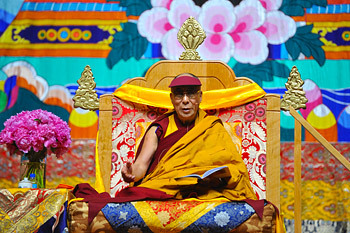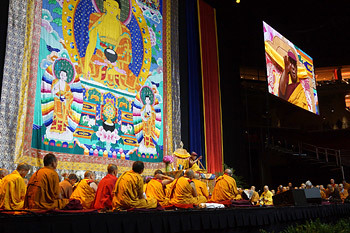Louisville, Kentucky, USA, 20 May 2013 - Returning to the Yum Center for a second day, before beginning his morning teaching session, His Holiness the Dalai Lama met with representatives of the Dalai Lama Fellows, young people working in different parts of the world in peace, justice and ecology. Their declared aim is ‘to build a world that works for every one of us because it’s increasingly clear that, otherwise, it won’t work for any of us.’ His Holiness was impressed by their reports and supportive of their various activities. He also so had a warm conversation with Archbishop Joseph Kurtz before meeting with a group of Tibetans resident in the vicinity of Louisville. He told them:
“We’ve been in exile now for 54 years, but there’s only a few of us compared to the 6 million Tibetans in Tibet. What we are free to do however, is to keep our language and culture alive. In the 7th century, Tibet was a powerful unified nation, and although it later became somewhat fragmented, through all the ups and downs, the people of the Land of Snow have continued to think of themselves as Tibetans. What unites us is our common language and culture. This is something to be proud of.”
Fervent applause filled the arena when His Holiness took the stage. As it subsided, its place was taken by the plaintive tones of a cello. His Holiness paid his respects before the throne, the backdrop to which was a huge appliqué thangka depicting the Buddha, before taking his seat.
“Good morning everybody,” he began, “I’m happy to be here with this opportunity, a morning and an afternoon session, to explain this particular text. It was written by a great Indian Buddhist master and philosopher in the eleventh century at the behest of the King of Guge, a small kingdom in Western Tibet. But before I open the text I’d like to say a little to set the context.”
He said that everyone has a mother and most of us receive tremendous affection from her. Among the audience of about 6000, those who received the maximum affection when they were young were most likely have grown into happy, secure adults. It is evident that those among our neighbours who are friendly and affectionate are happier.
“If you show concern for other’s well-being, speak honestly, cultivate affection and trust, you will naturally collect many firm friends. Scientific research has shown that positive meditation and mental training yield measurable improvements in well-being with reduced blood pressure and stress. The point is that some kind of spirituality improves our lives. “
Sensory experiences of watching sport, listening to music and so forth are short-lived material events. When the conditions that give rise to them come to an end, the satisfaction they provide vanishes. His Holiness recalled meeting an Indian family who asked him what he liked to watch on television. When he told them that he watches no television, but relies on BBC radio for news, the younger members of the family were incredulous and asked how he passes his time.
 |
| His Holiness the Dalai Lama speakingduring his teachings in Louisville, Kentucky on May 20, 2013. Photo/Sonam Zoksang |
By way of contrast, a Christian monk His Holiness met in Barcelona, who had spent five years in retreat in the mountains meditating on love, and in whose eyes he noted a special glow, was completely involved with mental experience.
“If you look at me,” His Holiness said, “your eye consciousness forms an image, but makes no judgement such as ‘This is my friend.’ Close your eyes and a mental image remains. Joy and wisdom function on that mental level; peace of mind is achieved through mental training. The love and compassion common to all major religions and their teachings about tolerance and patience also relate to training the mind.”
In Buddhism, he observed, we have the Pali tradition, found in Sri Lanka, Thailand, and Burma, while China, Japan, Korea, Vietnam, Tibet and Mongolia follow the Sanskrit tradition. In the Sanskrit tradition, external conduct is regulated by following the Vinaya, which is also common to the Pali tradition, while mental conduct is guided by the Bodhisattva code. Tantrayana uses physical exercises and energy to further our spiritual development. Sometimes, historically, due to misunderstandings the Sanskrit tradition has seemed to look down on the Pali tradition, which in turn has questioned whether the Sanskrit tradition is really the teaching of the Buddha.
A couple of years ago His Holiness was attending a World Parliament of Religions in Australia when two Burmese monks asked to see him. He put on his yellow robe to receive them. Recognising that they all followed the same teacher, the Buddha, they suggested that there were still differences between them. His Holiness agreed that there were differences, but said that the practice of both traditions was based on the Vinaya. The two monks, surprised, exclaimed, “You do that?”
The Sanskrit tradition makes great use of reason and critical enquiry. When Shantarakshita the great Indian master, logician and philosopher introduced Buddhism into Tibet in the 8th century, he emphasised the use of logic and epistemology. This was a key factor in making Tibet the heir to the Nalanda tradition. In their Buddhist training Tibetans memorise the root text, study each work and explore what they mean through debate.

|
Some of the over 6,000 people attending His Holiness the Dalai Lama's teaching in Louisville, Kentucky on May 20, 2013. Photo/Jeremy Russell/OHHDL
|
The author of this text Dipamkara Shrijnana Atisha was born in Bengal into a royal family that was linked to Shantarakshita’s family. He spent some time at Nalanda, but his main monastery was Vikramashila. His Holiness received the transmission and commentary to this text, ‘Lamp for the Path to Enlightenment’ from Serkong Tsenshap Rinpoche. It is called a ‘Lamp for the Path’ because it eliminates all misunderstandings concerning the path. The Tibetan translation begins with the Sanskrit title to show the text’s Indian origin.
The text categorises spiritual practitioners as of initial, medium and advanced capacities. The aim of a person of initial capacity is to gain relief from suffering through the practice of morality. The ten unwholesome deeds of body, speech and mind are, with the possible exception of wrong view, common to most religious traditions. Similarly, going for refuge is something they also have in common, despite their focussing on different objects. There is a common sense of not being confined only to this life or to material values.
A person of medium capacity seeks liberation from cyclic existence, while a person of advanced capacity develops the awakening mind of a bodhisattva and engages in the practice of the six perfections. Among these is the practice of concentration and His Holiness made it clear that this is something that can be cultivated by anyone, whatever tradition they follow. He suggested that anything can be selected as an object of concentration, and while Christians might choose a cross or the face of the Virgin Mary, Muslims might choose Mecca, while Buddhists commonly choose an image of the Buddha about an inch high, an arm’s length away, bright and heavy.
“It can be more useful to choose the breath as an object of concentration,” His Holiness elaborated, “because it is neither too coarse nor too subtle and it is a natural phenomenon. Observing it enables us to gather our minds as we count inhalations and exhalations as one, up to 21, 50 or 100.”
Moving rapidly further on through the text, he pointed out in relation to understanding emptiness that there comes a time to appraise the emptiness of the mind that understands the emptiness of inherent existence. Finally, although King Jangchub Ö had asked for a teaching appropriate for everyone, Atisha included a reference to the practice of tantra.
 |
| A view of the stage at the Yum Center, venue for His
Holiness the Dalai Lama's teaching in Louisville, Kentucky on May 20,
2013. Photo/Jeremy Russell/OHHDL |
“The text is complete,” His Holiness announced, adding, “I hope you are not tired. I hope non-Buddhists can find something useful in what I have explained. Buddhists I urge to read the text again and again; this is not something to be contented about. Material values and sensory pleasures have natural limits so it’s better to be contented with them. But mental qualities have no such limits, mind is formless and there is no limit to knowledge, so never feel contented with what you know; study more and more.”
He asked everyone to join together in reciting the Lamrim Dedication Prayer, which they did in English.
On behalf of the organisers, Ann Walter, expressed thanks to His Holiness, the sponsors and everyone who had contributed to the teachings as a volunteer. This was followed by the reading of a financial account.
His Holiness then offered some final words of advice:
“Mental development takes time. Early on it may seem difficult, but it becomes easier with familiarity. Don’t entertain unrealistic expectations; mental transformation doesn’t take place quickly. It requires patience and determination. It may take months or years, but at the end of your life you can feel confident about your next destination.
“Shantideva expresses the appropriate far-sighted perspective in his verse:
For as long as space endures,
And for as long as living beings remain,
Until then may I too abide
To dispel the misery of the world.”
















